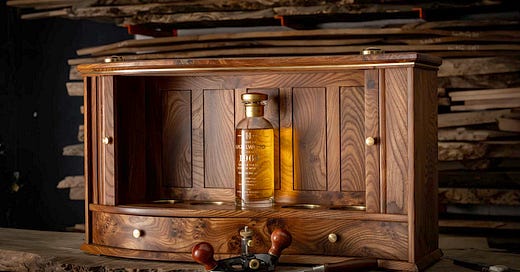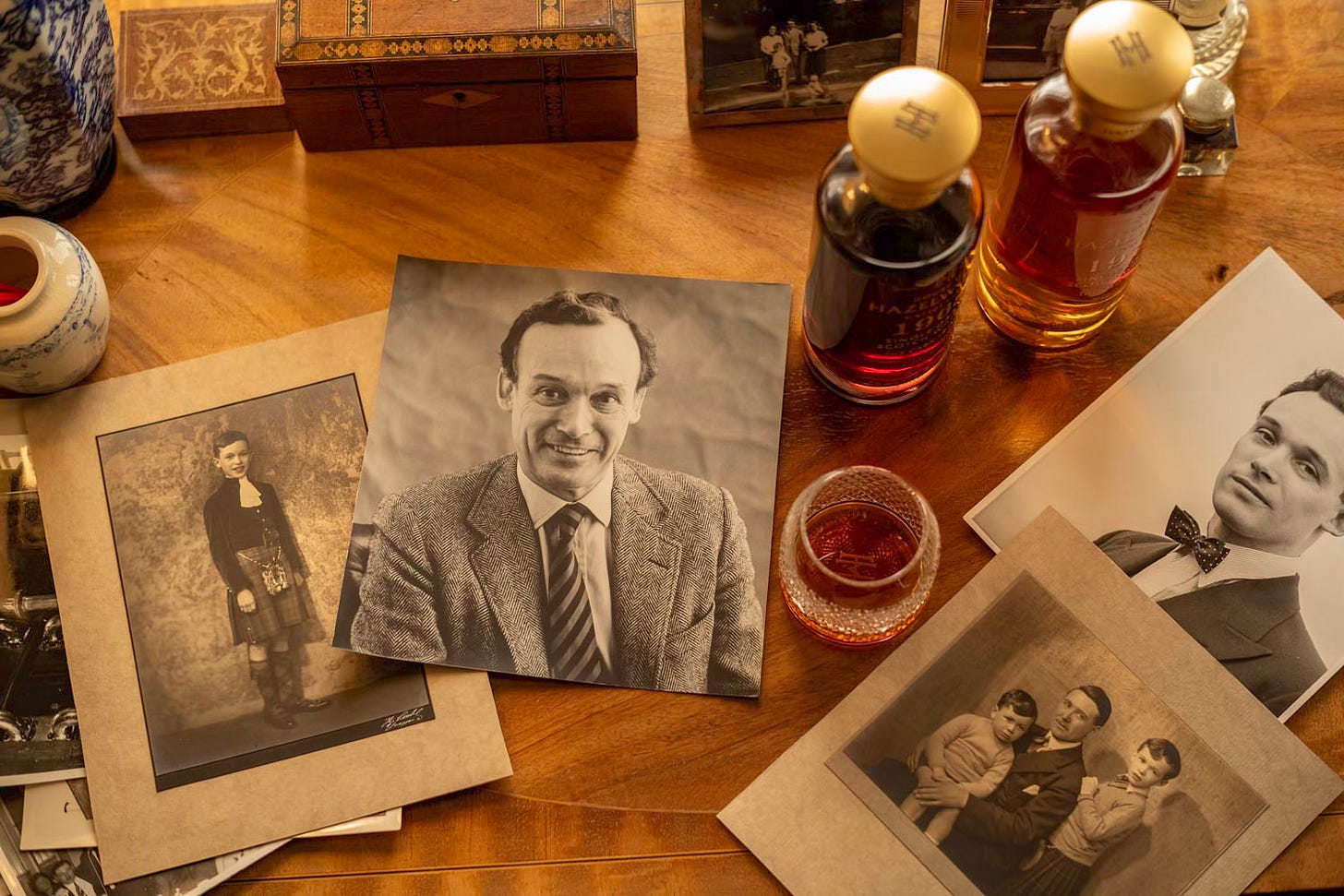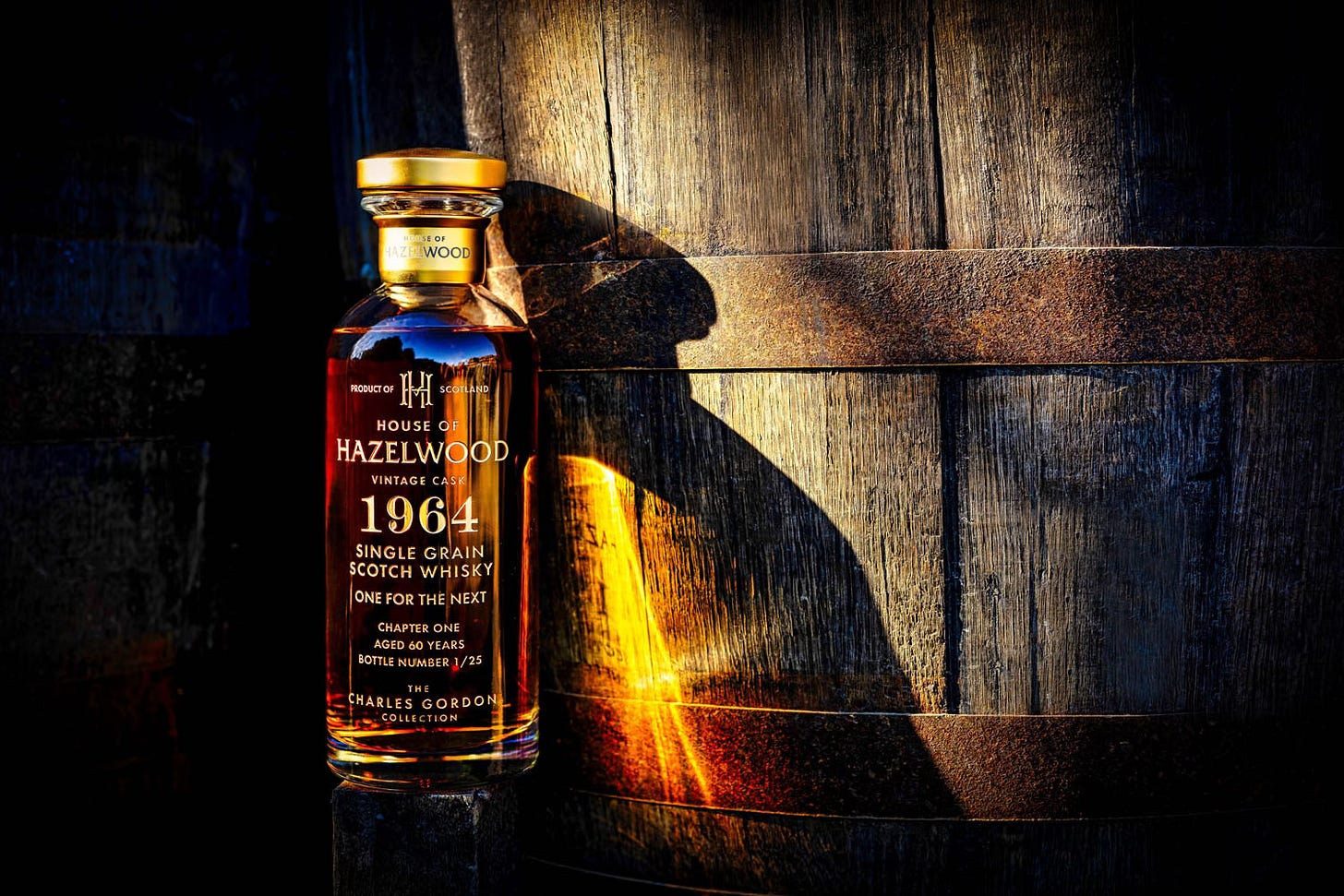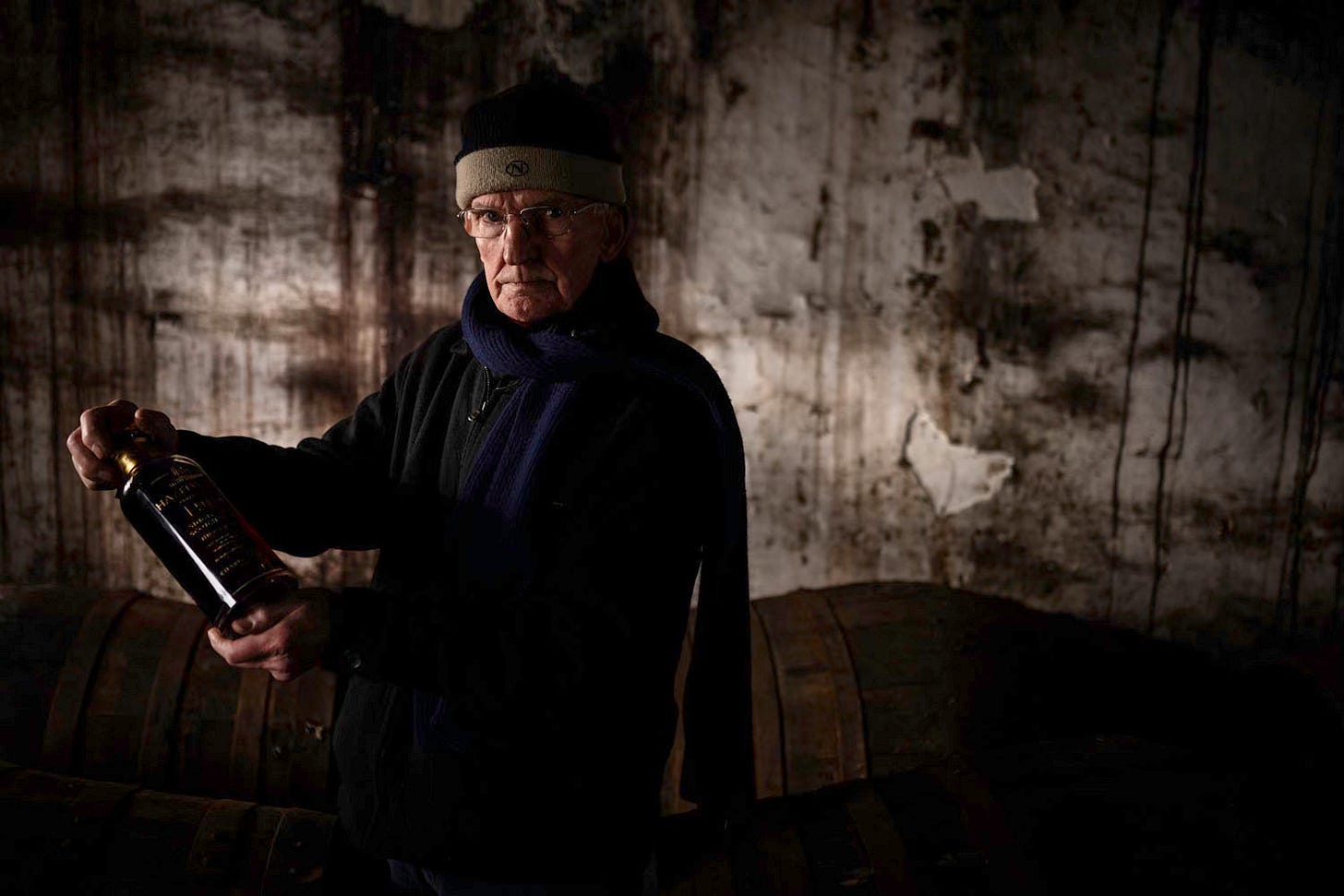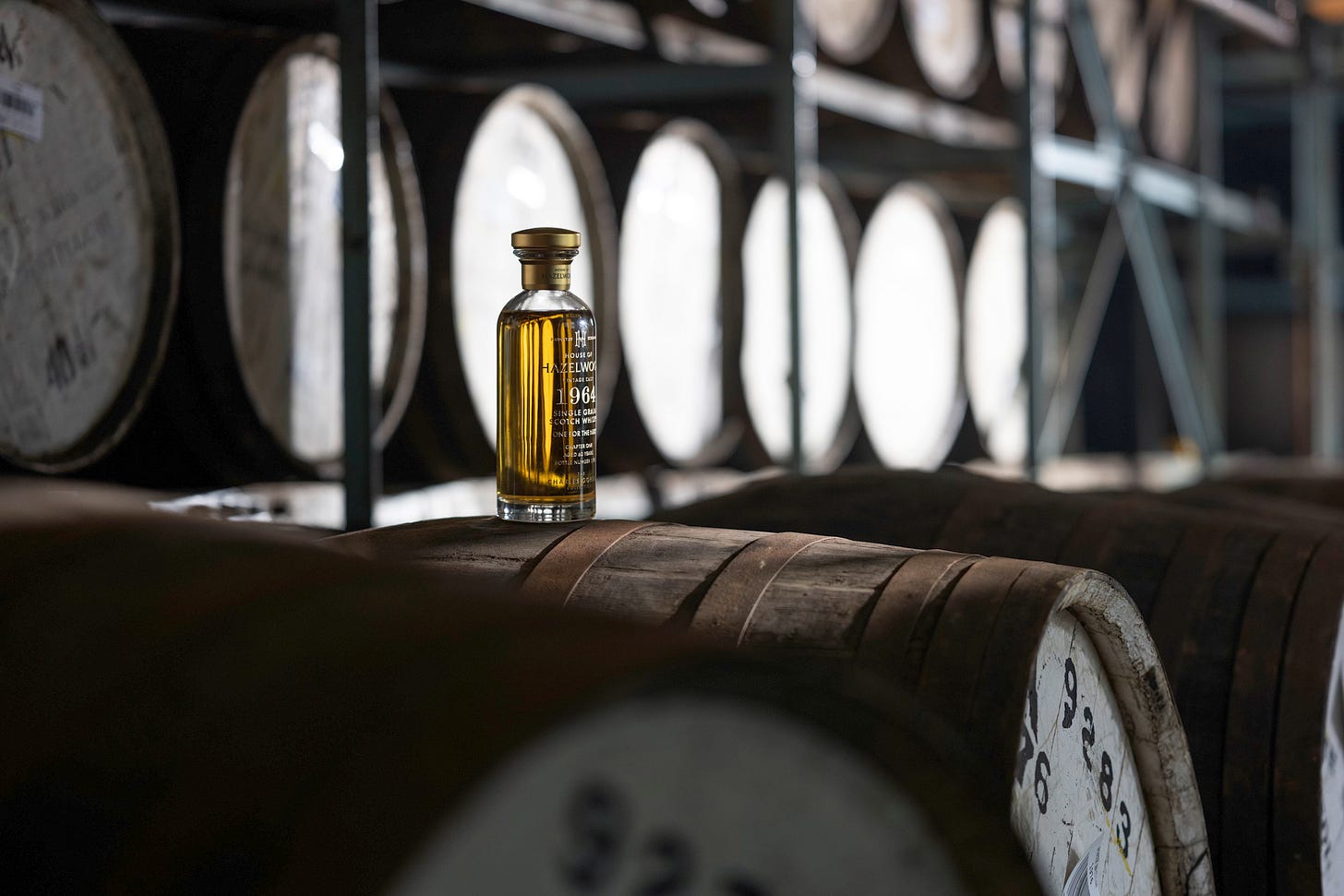House Of Hazelwood - One For The Next: The Whisky That Waits a Lifetime
One For The Next: The Whisky That Waits a Lifetime
Whisky is usually a drink of the present. You open it. You pour. You share a moment. You might talk about where it came from, but rarely where it’s going. The House of Hazelwood is inviting us to do something very different: to imagine whisky not for ourselves, but for those we’ll never meet.
One For The Next is more than just a whisky. It is a statement of intent. A quiet, deliberate act of trust in the future. This year, House of Hazelwood unveiled the first bottle in a five-part series that will take over 40 years to complete. It begins with a 60-year-old single grain whisky from Girvan, distilled in 1964 and laid down during the distillery's first full year of operation. A new expression will be released from the same cask every decade, culminating in a final bottling in 2065, aged 100 years. Those who purchase the first edition will be offered first refusal on each subsequent release. Not many things are designed with that kind of horizon.
Aptly named One For The Next, the collection reflects the Gordon family's long tradition of laying whisky down not for themselves, but for those yet to come. Created to mark the 60th anniversary of Girvan Distillery, a site that has quietly shaped the fortunes of the Gordon family since 1963, the series begins with a 60-Year-Old release from Girvan’s very first year of operation.
The ambition is bold: to follow the same whisky as it matures across the decades, with additional releases at 70, 80, 90 and 100 years. More than a collection, it is a generational heirloom in the making, designed to evolve, to endure, and to be handed on. Of Girvan Distillery itself, a fitting tribute to a site that has quietly shaped the fortunes of the Gordon family since 1963. That the first release is a 60-year-old whisky from Girvan’s very first year of operation is no coincidence; it’s a deliberate nod to where this story began. of laying whisky down not for themselves, but for those yet to come. The series will ultimately comprise five releases, each from the same vatting of casks first filled in 1964, matured decade by decade into whiskies aged 60, 70, 80, 90, and, eventually, 100 years. The ambition is clear: to create the oldest single-grain whisky ever bottled, to be passed down and added to over time.
There are press trips, and then there are experiences that shift your entire sense of what makes them meaningful. I was fortunate enough to join House of Hazelwood for the launch of One For The Next series, an event that began on Scotland's rugged west coast at Girvan and concluded at the Gordon family's ancestral home in Speyside.
To taste a whisky older than the digital age, inside the private home of the family who created it, and in the company of writers, historians, craftspeople and industry stewards, is not something you can simply add to a cart or wishlist. It’s a privilege, yes, but more than that, it offers a powerful sense of place. It reminds you that while William Grant & Sons is one of the largest drinks companies in the world, behind Glenfiddich, The Balvenie, and Hendrick’s lies a family business. I truly felt the passion and pride for The House of Hazelwood, and the legacy drawn from the family’s own private reserves.
Our visit began at Girvan, a colossal grain distillery founded in 1963 by Charles Gordon following a well-documented rift with the Distillers Company Limited. Built in just nine months, it was, in many ways, the whisky industry’s moonshot: a bold act of independence and ambition. The casks used for One For The Next were filled in 1964, Girvan's first year of operation. Several of these original casks have been combined to form this inaugural release. Each cask chosen can trace its lineage back to Charles Gordon himself, who oversaw their filling during Girvan’s earliest days. These were never intended for sale, but for family use, part of a quiet, personal collection that would ultimately evolve into what we now know as the House of Hazelwood. From this vatting, just 25 bottles of the 60-Year-Old have been filled. The rest has been transferred into specially made European oak hogsheads.
These custom casks, built with thicker staves and intended to support ultra-long-term ageing, will carry the remaining whisky through the decades ahead. Today, those precious casks rest not by the coast, but in Speyside, maturing in the basement of a cool, quiet dunnage warehouse on the Balvenie estate. No longer destined for blends or mass-market releases, they now carry the weight of legacy, a story still being written for just 25 fortunate individuals.
Immersion was a theme of the trip. My accommodation was on the family estate. It’s a serene place, one that slows your pulse and pulls you gently into its rhythm. I played snooker with fellow writers in a lounge that offered sweeping views of the still house through floor-to-ceiling windows. We sipped whisky and spoke about Girvan, about Charles Gordon’s foresight in laying down these casks. It must have felt like an experiment at the time. Could grain whisky really transform with age? The answer, it turns out, is yes.
That evening, we dined at Hazelwood House itself. I’d visited before, but the feeling never fades. To sit in a family home that has housed six generations of the Gordons, to drink from their cellar and eat at their table, is unforgettable.
We began with Champagne in the garden as the sun dipped behind the trees, the light golden, almost too perfect. Kirsten Grant Meikle, Charles Gordon’s great-niece, welcomed us with warmth. She is engaging, humorous, passionate, and deeply present. She must meet hundreds of industry people every year, yet somehow remembers everyone.
Dinner was paired with wine and whisky. First came the Eight Grain 40-Year-Old, a poised, elegant expression. Then the Transatlantic 33-Year-Old, marrying American and Scottish grain techniques with a quiet modernity. And finally, the centrepiece: the 60-Year-Old, One For The Next.
Tasting notes offer words like barley sugar, citrus peel, and toasted almond. But that barely scratches the surface. There is no heat. No aggression. It doesn't demand anything of you. It simply arrives, soft, supple, assured. Old without feeling tired. A whisky that feels less like a product and more like a presence.
It is easy to imagine someone discovering this whisky a century from now and marvelling at its restraint, its poise. This is a spirit that has been nurtured, not nudged. It is a time capsule in liquid form. And yet, perhaps more powerful than the flavour was the realisation that this might be the last time this whisky is tasted publicly for a decade or more. For many who buy it, the final bottle, the 100-Year-Old, will be released long after they’re gone. One For The Next is not a whisky you buy to enjoy. It is one you buy to be remembered for.
Before dinner, the bottle’s presentation cabinet was unveiled. Made by award-winning Scottish cabinetmaker Paul Hodgkiss from wind-felled elm harvested on the Hazelwood estate, it is more sculpture than storage. With tambour doors, secret compartments, and time-lock mechanisms, it resembles an heirloom more than a display case.
Paul told us it took around 282 hours to complete. Each cabinet is unique. The wood, shaped by age and storm, provides a tactile connection to the land. Inside, a hidden drawer holds a handwritten message, a certificate of ownership, and a photography book chronicling the collection. Another compartment allows owners to leave a message for their descendants. Few luxury goods are created with this kind of emotional foresight.
The most moving moment of the evening came when we were joined by Dennis McBain: coppersmith, storyteller, and one of the last living links to Charles and Sandy Gordon’s original team. It is always a privilege to hear him speak.
Dennis began his career in 1958. He started in malting but soon found himself shaping copper stills by hand. “You need vision, ” he said. “People think it’s just hitting metal, but you’re shaping something alive. There’s a rhythm to it. A logic.”
When Girvan was built, Charles Gordon insisted on having in-house coppersmiths. Dennis was one of them. He worked on-site, repairing stills, watching them reach the end of their lives after producing tens of millions of litres. He remembers Charles not as a distant figure, but as a man who walked the site and asked direct questions. “You couldn’t bluff him, ” Dennis said. “He already knew the answer. He just wanted to see if you did.”
Eventually, Dennis became Charles’s driver, confidante, and collaborator. They travelled Scotland together, researching family history and exploring places half-remembered from childhood. Their relationship was rare, built on mutual respect, curiosity, and time.
His story, like the whisky itself, is a reminder: it is people, not processes, that make the difference.
Buyers of the 60-Year-Old gain access to a private microsite tracking the cask's journey over time. They receive samples, updates, invitations, and eventually, the chance to purchase the next release. The site will also offer annual updates on the whisky’s development and allow for the formal transfer of ownership to future generations. Priced at £10,000 and available exclusively via House of Hazelwood and WG&S Distillers Libraries, this inaugural edition is limited to just 25 bottles. More than a purchase, it is an invitation to become part of the whisky’s story, to help carry it forward. But more than that, buyers are encouraged to think generationally. To record something. To pass it on.
In an era increasingly defined by speculative bottle flipping and rapid-fire releases, One For The Next stands apart. This is not a whisky for the impatient or the opportunistic. It is for those who understand whisky as a long-form expression of care, of time, of belief in the future.
As Jonathan Gibson, House of Hazelwood’s director, put it, “This isn’t about investment. It’s about intention. This is whisky for people who understand the value of waiting.”
One For The Next is not about nostalgia. It is about possibility. It dares to ask a question few producers have asked: What if we made something designed to outlast us?
It is a whisky that challenges the pace of modern life. That reminds us legacy can be built quietly. That craftsmanship still matters more than content. That time, even now, still has a place in the making of something great.
